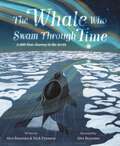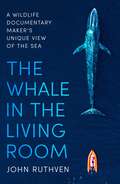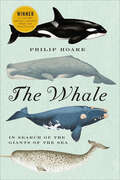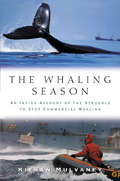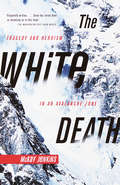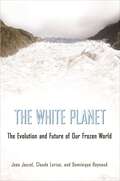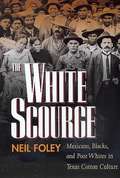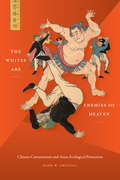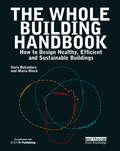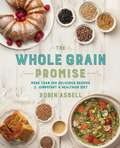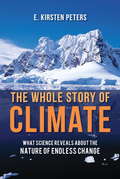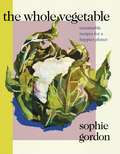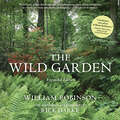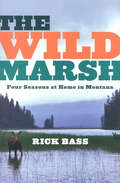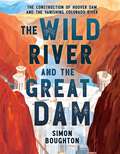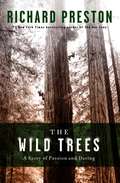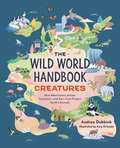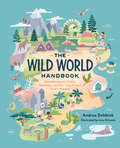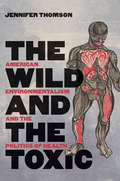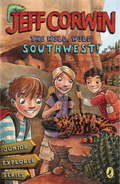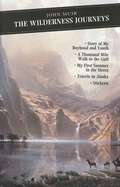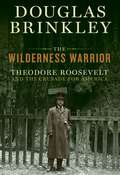- Table View
- List View
The Whale Who Swam Through Time: A Two-Hundred-Year Journey in the Arctic
by Nick Pyenson Alex BoersmaThis sweeping nonfiction picture book The Whale Who Swam Through Time explores the 200-year lifespan of a bowhead whale and the changing environment that surrounds her.Almost 200 years ago . . .Our journey begins with the birth of a bowhead whale, the longest-living mammal in the world. Over the course of her life in the Arctic, the bowhead whale witnesses many changes: from an era of peace and solitude to one of oil rigs and cruise liners.With gorgeous, detailed, and striking illustrations, this well researched and thoughtfully curated nonfiction story captures the magic and beauty of the natural world, while also providing a thoughtful account of how humans have impacted our changing ecosystems and a call-to-action for protecting the environment.
The Whale in the Living Room
by John RuthvenThe Whale in the Living Room follows the thrilling adventures of award-winning wildlife documentary producer, John Ruthven, on a journey of discovery - by turns memorable, touching and often funny -that has helped the undersea world flow into countless living rooms to reveal many of our ocean's mysteries.John is the only producer to have worked on both Blue Planet and Blue Planet II, presented by David Attenborough, in total making nearly fifty ocean films, including episodes of Discovery Shark Week, expedition films for National Geographic and coral conservation documentaries for PBS. With innovative technology he has helped capture unique images of a sperm whale mother and calf, pictures of glowing creatures half a mile deep, and grey reef sharks hunting by the light of the moon. We swim with him through blue lagoons, dive into the abyss to encounter new life forms, and experience everything from the danger of getting lost at sea to the sadness of finding a starving whale with a fishing net caught in its mouth. Through each remarkable adventure, John gives insight into what we currently know about the ocean, and our whole blue planet, revealing that the sea really is the 'saltwater country' the Yolngu people of Australia know it to be - a place with as many unique destinations in water as on land.John's book also explores why we have remained largely blind to the pollution in our oceans until recently and charts how plastic 'went wild' in the sea, to understand how we might begin to clear up the mess.
The Whale in the Living Room: A Wildlife Documentary Maker's Unique View of the Sea
by John RuthvenThe Whale in the Living Room follows the thrilling adventures of award-winning wildlife documentary producer, John Ruthven, on a journey of discovery - by turns memorable, touching and often funny -that has helped the undersea world flow into countless living rooms to reveal many of our ocean's mysteries.John is the only producer to have worked on both Blue Planet and Blue Planet II, presented by David Attenborough, in total making nearly fifty ocean films, including episodes of Discovery Shark Week, expedition films for National Geographic and coral conservation documentaries for PBS. With innovative technology he has helped capture unique images of a sperm whale mother and calf, pictures of glowing creatures half a mile deep, and grey reef sharks hunting by the light of the moon. We swim with him through blue lagoons, dive into the abyss to encounter new life forms, and experience everything from the danger of getting lost at sea to the sadness of finding a starving whale with a fishing net caught in its mouth. Through each remarkable adventure, John gives insight into what we currently know about the ocean, and our whole blue planet, revealing that the sea really is the 'saltwater country' the Yolngu people of Australia know it to be - a place with as many unique destinations in water as on land.John's book also explores why we have remained largely blind to the pollution in our oceans until recently and charts how plastic 'went wild' in the sea, to understand how we might begin to clear up the mess.
The Whale: In Search of the Giants of the Sea
by Philip HoareA travelogue through the history, literature, and lore of the remarkable mammals that we long have been fascinated with, from Moby-Dick to Free Willy.From his childhood fascination with the gigantic Natural History Museum model of a blue whale, to his abiding love of Moby-Dick, to his adult encounters with the living animals in the Atlantic Ocean, the acclaimed writer Philip Hoare has been obsessed with whales. The Whale is his unforgettable and moving attempt to explain why these strange and beautiful animals exert such a powerful hold on our imagination.Praise for The WhaleWinner of the Samuel Johnson Prize for Non-Fiction“This tour de force is a sensuous biography of the great mammals that range on and under Earth’s oceans.” —Publishers Weekly, starred review“The Whale is part cultural study, part travelogue, as Hoare traces the footsteps of Herman Melville from New York to New Bedford and Nantucket . . . [and] digresses on our abuses of the whale and the devastations of the whaling industry.” —Boston Globe“One of the most sublime reading experiences you’ll have this year.” —NPR’S All Things Considered
The Whaling Season: An Inside Account Of The Struggle To Stop Commercial Whaling
by Kieran MulvaneyDespite a decades-long international moratorium on commercial whaling, one fleet has continued to hunt and kill whales in the waters surrounding Antarctica. Refusing to let this defiance go unchallenged, the environmental organization Greenpeace began dispatching expeditions to the region in an effort to intercept the whalers and use nonviolent means to stop their lethal practice.Over the past decade, Kieran Mulvaney led four such expeditions as a campaigner and coordinator. In The Whaling Season, he recounts those voyages in all their drama, disappointments, strain, and elation, giving readers a behind-the-scenes look at the hazards and triumphs of life as an environmental activist on the high seas. The author also explores the larger struggles underlying the expeditions, drawing on the history of commercial whaling and Antarctic exploration, the development of Greenpeace, and broader scientific and political efforts to conserve marine life. He presents a rich portrait of the current struggles and makes an impassioned plea for protection of some of the world's most spectacular creatures.For armchair adventurers, polar enthusiasts, and anyone concerned about marine conservation and continued hunting of the world's whales, The Whaling Season is an engrossing and informative tale of adventure set in one of the Earth's last great wilderness areas."
The White Death: Tragedy and Heroism in an Avalanche Zone
by Mckay JenkinsIn 1969, five young men from Montana set out to accomplish what no one had before: to scale the sheer north face of Mt. Cleveland, Glacier National Park's tallest mountain, in winter. Two days later tragedy struck: they were buried in an avalanche so deep that their bodies would not be discovered until the following June. The White Death is the riveting account of that fated climb and of the breathtakingly heroic rescue attempt that ensued. In the spirit of Peter Matthiessen and John McPhee, McKay Jenkins interweaves a harrowing narrative with an astonishing expanse of relevant knowledge ranging from the history of mountain climbing to the science of snow. Evocative and moving, this fascinating book is a humbling account of man at his most intrepid and nature at its most indomitable.
The White Planet: The Evolution and Future of Our Frozen World
by Jean Jouzel Claude Lorius Dominique RaynaudA gripping journey through the icy regions of our changing planetFrom the Arctic Ocean and ice sheets of Greenland, to the glaciers of the Andes and Himalayas, to the great frozen desert of Antarctica, The White Planet takes readers on a spellbinding scientific journey through the shrinking world of ice and snow to tell the story of the expeditions and discoveries that have transformed our understanding of global climate. Written by three internationally renowned scientists at the center of many breakthroughs in ice core and climate science, this book provides an unparalleled firsthand account of how the "white planet" affects global climate—and how, in turn, global warming is changing the frozen world.Jean Jouzel, Claude Lorius, and Dominique Raynaud chronicle the daunting scientific, technical, and human hurdles that they and other scientists have had to overcome in order to unravel the mysteries of past and present climate change, as revealed by the cryosphere--the dynamic frozen regions of our planet. Scientifically impeccable, up-to-date, and accessible, The White Planet brings cutting-edge climate research to general readers through a vivid narrative. This is an essential book for anyone who wants to understand the inextricable link between climate and our planet's icy regions.
The White Scourge: Mexicans, Blacks, and Poor Whites in the Cotton Culture
by Neil FoleyA powerful, award-winning work of social history about race, class and labor in Texas from post-civil war to the Depression.
The Whites Are Enemies of Heaven: Climate Caucasianism and Asian Ecological Protection
by Mark W. DriscollIn The Whites Are Enemies of Heaven Mark W. Driscoll examines nineteenth-century Western imperialism in Asia and the devastating effects of "climate caucasianism"—the white West's pursuit of rapacious extraction at the expense of natural environments and people of color conflated with them. Drawing on an array of primary sources in Chinese, Japanese, and French, Driscoll reframes the Opium Wars as "wars for drugs" and demonstrates that these wars to unleash narco- and human traffickers kickstarted the most important event of the Anthropocene: the military substitution of Qing China's world-leading carbon-neutral economy for an unsustainable Anglo-American capitalism powered by coal. Driscoll also reveals how subaltern actors, including outlaw societies and dispossessed samurai groups, became ecological protectors, defending their locales while driving decolonization in Japan and overthrowing a millennia of dynastic rule in China. Driscoll contends that the methods of these protectors resonate with contemporary Indigenous-led movements for environmental justice.
The Whole Building Handbook: How to Design Healthy, Efficient and Sustainable Buildings
by Maria Block Varis BokaldersThe Whole Building Handbook is a compendium of all the issues and strategies that architects need to understand to design and construct sustainable buildings for a sustainable society. The authors move beyond the current definition of sustainability in architecture, which tends to focus on energy-efficiency, to include guidance for architecture that promotes social cohesion, personal health, renewable energy sources, water and waste recycling systems, permaculture, energy conservation - and crucially, buildings in relation to their place. The authors offer a holistic approach to sustainable architecture and authoritative technical advice, on: * How to design and construct healthy buildings, through choosing suitable materials, healthy service systems, and designing a healthy and comfortable indoor climate, including solutions for avoiding problems with moisture, radon and noise as well as how to facilitate cleaning and maintenance. * How to design and construct buildings that use resources efficiently, where heating and cooling needs and electricity use is minimized and water-saving technologies and garbage recycling technologies are used. * How to 'close' organic waste, sewage, heat and energy cycles. For example, how to design a sewage system that recycles nutrients. * Includes a section on adaptation of buildings to local conditions, looking at how a site must be studied with respect to nature, climate and community structure as well as human activities. The result is a comprehensive, thoroughly illustrated and carefully structured textbook and reference.
The Whole Grain Promise: More Than 100 Recipes to Jumpstart a Healthier Diet
by Robin AsbellFrom quinoa to bulgar and millet to kasha, whole grains add a hearty, healthy, and flavorful boost to any meal. In The Whole Grain Promise, Robin Asbell shares quick and easy whole grain recipes that will entice the pickiest eater and appeal to the whole family. Whether you want to improve your health or try something new for dinner, whole grains are the perfect place to start. Beginning with the basics, Robin takes you through the major types of grains, their health benefits, and how best to cook them. From there, she offers more than 100 mouthwatering recipes that will encourage everyone to embrace the whole grain diet. With everything from Grain-Crust Spinach Cauliflower Quiche to Fudgy Brownie Cupcakes, The Whole Grain Promise will tempt your family with food that's not only healthy, but delicious!
The Whole Story of Climate
by E. Kirsten PetersAccessible and engagingly written, this book is essential reading for anyone looking to understand one of our most important contemporary debates. In the publicity surrounding global warming, climate scientists are usually the experts consulted by the media. We rarely hear from geologists, who for almost two hundred years have been studying the history of Earth's dramatic and repeated climate revolutions, as revealed in the evidence of rocks and landscapes. This book, written by a geologist, describes the important contributions that geology has made to our understanding of climate change. What emerges is a much more complex and nuanced picture than is usually presented. While the average person often gets the impression that the Earth's climate would be essentially stable if it weren't for the deleterious effects of greenhouse gases, in fact the history of the earth over many millennia reveals a constantly changing climate. As the author explains, several long cold eras have been punctuated by shorter warm periods. The most recent of these warm spells, the one in which we are now living, started ten thousand years ago; based on previous patterns, we should be about due for the return of another frigid epoch. Some scientists even think that the warming of the planet caused by man-made greenhouse gasses tied to agriculture in the past few thousand years may have held off the next ice age. Though this may be possible, much remains uncertain. But what is clearly known is that major climate shifts can be appallingly rapid-occurring over as little as twenty or thirty years. One danger of dumping greenhouse gases into the atmosphere is that they may increase the chance that this "climate switch" will be thrown, with catastrophic effects on worldwide agriculture. Besides her discussion of climate, the author includes chapters on how early naturalists pieced together the complicated geological history of Earth, and she teaches the reader how to interpret the evidence of rock formations and landscape patterns all around us.
The Whole Vegetable: Sustainable and delicious vegan recipes
by Sophie GordonDiscover wholesome, sustainable and plant-based dishes in this essential cookbook, perfect for anyone looking to reduce their waste this year!'Hearty, healthy, flavour-packed dishes' MAIL ON SUNDAY'A uniquely sustainable and delicious approach to modern plant-based cooking' VOGUE'The Whole Vegetable blew me away . . . Full of inventive waste-free recipes' Tom Hunt, GUARDIAN_________Have you ever wondered how to make your diet truly eco-conscious?In this beautiful plant-based cookbook, over 130 creative, delicious, planet-friendly recipes put vegetables at the very centre of the table. Embracing often-discarded parts such as leaves, stalks, tops, flowers, seeds and even peelings, this is cooking at its most sustainable.In The Whole Vegetable, Sophie Gordon shows us how to:- Cook with every part of every vegetable- Reduce waste in your cooking- Reinvent your leftovers- Eat with the seasonsFrom Cauliflower Carbonara, Broccoli Pesto and Chunky Pumpkin Tacos, to Cherry Breakfast Crumble, Maple-Roasted Pears and Apple & Walnut Danish Buns, The Whole Vegetable is packed with thoughtful recipes for every season.Most of all, it will ensure that nothing in your kitchen goes to waste._________'Creative, delicious, planet-friendly recipes . . . Teaches you how to put those often discarded parts of fruit and veg to good (and tasty) use' Women's Health'Wow, Sophie Gordon's . . . The Whole Vegetable blew me away. I wonder if she is the next Anna Jones. A seasonal, plant-centric, whole food recipe book without ultra-processed vegan ingredients. The recipes are super-inventive and importantly waste free!' Eco-Chef Tom Hunt'The Whole Vegetable heroes plant-based cookery, with recipes that also help reduce food waste in the kitchen and improve sustainable living. A worthwhile read' Good Housekeeping
The Wild Garden: Expanded Edition
by William Robinson Rick DarkeFirst published in 1870, The Wild Garden challenged the prevailing garden style of the day and advocated a naturalistic style, in which hardy plants, both native and exotic, are arranged in groupings that mimic wild landscapes. Thanks to Robinson’s passionate advocacy, the naturalistic style triumphed, and Robinson's urgent message continues to resonate today. For this newly designed edition, Rick Darke has written an introductory essay that not only underscores Robinson’s importance in the evolution of garden design and ecology, but also explains his relevance for today’s gardeners, designers, and landscape professionals. The book contains over 100 stunning photographs taken by Darke, including images of Gravetye and of modern “wild” gardens.
The Wild Marsh: Four Seasons at Home in Montana
by Rick BassThe Wild Marsh is Rick Bass's most mature, full account of life in the Yaak and a crowning achievement in his celebrated career. It begins with his family settling in for the long Montana winter, and captures all the subtle harbingers of change that mark each passing month -- the initial cruel teasing of spring, the splendor and fecundity of summer, and the bittersweet memories evoked by fall. It is full of rich observation about what it takes to live in the valley -- ruggedness, improvisation and, of course, duct tape. The Wild Marsh is also tremendously poignant, especially when Bass reflects on what it means for his young daughters to grow up surrounded by the strangeness and wonder of nature. He shares with them the Yaak's little secrets -- where the huckleberries are best in a dry year, where to find a grizzly's claw marks in an old cedar -- and discovers that passing on this intimate local knowledge, the knowledge of home, is a kind of rare and valuable love. Bass emerges not just as a writer but as a father, a neighbor, and a gifted observer, uniquely able to bring us close to the drama and sanctity of small things, ensuring that though the wilderness is increasingly at risk, the voice of the wilderness will not disappear.
The Wild River and the Great Dam: The Construction of Hoover Dam and the Vanishing Colorado River
by Simon BoughtonDiscover the complicated history behind the construction of Hoover Dam—one of the country’s most recognizable and far-reaching landmarks—and its lasting political and environmental effects on the Colorado River and the American West. <P><P> At the time of its completion in 1936, Hoover Dam was the biggest dam in the world and the largest feat of architecture and engineering in the country—a statement of national ambition and technical achievement. It turned the wild Colorado River into a tame and securely managed water source, transforming millions of acres of desert into farmland while also providing water and power to the fast-growing population of the Southwest. The concrete monolith quickly became a symbol of American ingenuity; however, its history is laden with contradiction. It provided work for thousands, but it was a dangerous project that exploited desperate workers during the Depression. It helped secure the settlement and economies of the Southwest, but at the expense of Indigenous peoples and the environment; and it created a dependency on the Colorado River’s water, which is under threat from overuse and climate change. <P><P> Weaving together elements of engineering, geography, and political and socioeconomic history, and drawing heavily from unpublished oral histories taken from dam workers and their families, Simon Boughton’s thoughtful and compelling debut—featuring historical photographs throughout—follows the construction and impact of Hoover Dam, and how its promise of abundance ultimately created a river in crisis today.
The Wild Trees: A Story of Passion and Daring
by Richard PrestonHidden away in foggy, uncharted rain forest valleys in Northern California are the largest and tallest organisms the world has ever sustained–the coast redwood trees, Sequoia sempervirens. Ninety-six percent of the ancient redwood forests have been destroyed by logging, but the untouched fragments that remain are among the great wonders of nature. The biggest redwoods have trunks up to thirty feet wide and can rise more than thirty-five stories above the ground, forming cathedral-like structures in the air. Until recently, redwoods were thought to be virtually impossible to ascend, and the canopy at the tops of these majestic trees was undiscovered. In The Wild Trees, Richard Preston unfolds the spellbinding story of Steve Sillett, Marie Antoine, and the tiny group of daring botanists and amateur naturalists that found a lost world above California, a world that is dangerous, hauntingly beautiful, and unexplored. The canopy voyagers are young–just college students when they start their quest–and they share a passion for these trees, persevering in spite of sometimes crushing personal obstacles and failings. They take big risks, they ignore common wisdom (such as the notion that there’s nothing left to discover in North America), and they even make love in hammocks stretched between branches three hundred feet in the air. The deep redwood canopy is a vertical Eden filled with mosses, lichens, spotted salamanders, hanging gardens of ferns, and thickets of huckleberry bushes, all growing out of massive trunk systems that have fused and formed flying buttresses, sometimes carved into blackened chambers, hollowed out by fire, called “fire caves.” Thick layers of soil sitting on limbs harbor animal and plant life that is unknown to science. Humans move through the deep canopy suspended on ropes, far out of sight of the ground, knowing that the price of a small mistake can be a plunge to one’s death. Preston’s account of this amazing world, by turns terrifying, moving, and fascinating, is an adventure story told in novelistic detail by a master of nonfiction narrative. The author shares his protagonists’ passion for tall trees, and he mastered the techniques of tall-tree climbing to tell the story in The Wild Trees–-the story of the fate of the world’s most splendid forests and of the imperiled biosphere itself.
The Wild Trees: A Story of Passion and Daring
by Richard PrestonHidden away in foggy, uncharted rain forest valleys in Northern California are the largest and tallest organisms the world has ever sustained-the coast redwood trees, Sequoia sempervirens. Ninety-six percent of the ancient redwood forests have been destroyed by logging, but the untouched fragments that remain are among the great wonders of nature. The biggest redwoods have trunks up to thirty feet wide and can rise more than thirty-five stories above the ground, forming cathedral-like structures in the air. Until recently, redwoods were thought to be virtually impossible to ascend, and the canopy at the tops of these majestic trees was undiscovered. In The Wild Trees, Richard Preston unfolds the spellbinding story of Steve Sillett, Marie Antoine, and the tiny group of daring botanists and amateur naturalists that found a lost world above California, a world that is dangerous, hauntingly beautiful, and unexplored. The canopy voyagers are young-just college students when they start their quest-and they share a passion for these trees, persevering in spite of sometimes crushing personal obstacles and failings. They take big risks, they ignore common wisdom (such as the notion that there's nothing left to discover in North America), and they even make love in hammocks stretched between branches three hundred feet in the air.The deep redwood canopy is a vertical Eden filled with mosses, lichens, spotted salamanders, hanging gardens of ferns, and thickets of huckleberry bushes, all growing out of massive trunk systems that have fused and formed flying buttresses, sometimes carved into blackened chambers, hollowed out by fire, called "fire caves." Thick layers of soil sitting on limbs harbor animal and plant life that is unknown to science. Humans move through the deep canopy suspended on ropes, far out of sight of the ground, knowing that the price of a small mistake can be a plunge to one's death.Preston's account of this amazing world, by turns terrifying, moving, and fascinating, is an adventure story told in novelistic detail by a master of nonfiction narrative. The author shares his protagonists' passion for tall trees, and he mastered the techniques of tall-tree climbing to tell the story in The Wild Trees-the story of the fate of the world's most splendid forests and of the imperiled biosphere itself.From the Hardcover edition.
The Wild Trees: A Story of Passion and Daring
by Richard PrestonHidden away in foggy, uncharted rain forest valleys in Northern California are the largest and tallest organisms the world has ever sustained-the coast redwood trees, Sequoia sempervirens. Ninety-six percent of the ancient redwood forests have been destroyed by logging, but the untouched fragments that remain are among the great wonders of nature. The biggest redwoods have trunks up to thirty feet wide and can rise more than thirty-five stories above the ground, forming cathedral-like structures in the air. Until recently, redwoods were thought to be virtually impossible to ascend, and the canopy at the tops of these majestic trees was undiscovered. In The Wild Trees, Richard Preston unfolds the spellbinding story of Steve Sillett, Marie Antoine, and the tiny group of daring botanists and amateur naturalists that found a lost world above California, a world that is dangerous, hauntingly beautiful, and unexplored. The canopy voyagers are young-just college students when they start their quest-and they share a passion for these trees, persevering in spite of sometimes crushing personal obstacles and failings. They take big risks, they ignore common wisdom (such as the notion that there's nothing left to discover in North America), and they even make love in hammocks stretched between branches three hundred feet in the air.The deep redwood canopy is a vertical Eden filled with mosses, lichens, spotted salamanders, hanging gardens of ferns, and thickets of huckleberry bushes, all growing out of massive trunk systems that have fused and formed flying buttresses, sometimes carved into blackened chambers, hollowed out by fire, called "fire caves." Thick layers of soil sitting on limbs harbor animal and plant life that is unknown to science. Humans move through the deep canopy suspended on ropes, far out of sight of the ground, knowing that the price of a small mistake can be a plunge to one's death.Preston's account of this amazing world, by turns terrifying, moving, and fascinating, is an adventure story told in novelistic detail by a master of nonfiction narrative. The author shares his protagonists' passion for tall trees, and he mastered the techniques of tall-tree climbing to tell the story in The Wild Trees-the story of the fate of the world's most splendid forests and of the imperiled biosphere itself.From the Hardcover edition.
The Wild World Handbook: Creatures (The Wild World Handbook #2)
by Andrea DebbinkPacked with real-life tales of adventure, breathtaking illustrations, and practical tools, this handbook is an inspiring guide for the next generation of climate activists, conservationists, and nature lovers.We share this incredible planet we call home with countless living creatures, from butterflies and falcons to koalas and dolphins. And just like us, animals everywhere are faced with the growing threat of climate change. Featuring seven categories of creatures, this handbook offers a roadmap for change and an invitation to explore the outdoors with fascinating facts, hope-filled stories, and hands-on STEAM activities. Each chapter highlights the biographies of scientists, artists, and adventurers from diverse backgrounds who have used their passion and skills to become courageous advocates for animals around the world. The second book in a middle-grade series for young activists and conservationists, The Wild World Handbook: Creatures empowers readers to appreciate and protect Earth&’s wildlife.Inside you will find: • Seven incredible categories of creatures • Fourteen inspiring biographies • Seven kid-friendly DIY activities • Seven fun field trips • And much more!
The Wild World Handbook: Habitats (The Wild World Handbook #1)
by Andrea DebbinkPacked with real-life tales of adventure, breathtaking illustrations, and practical tips, this handbook is an inspiring guide for the next generation of climate activists, conservationists, and nature lovers.The wonder of the natural world surrounds us—from the Amazon rainforest to the snowy peaks of Mount Everest to the green spaces in big cities. And as the threat of climate change grows, it&’s more important than ever to show appreciation for our planet by taking action.The first book in a middle grade series for young environmental activists and nature lovers, The Wild World Handbook offers a roadmap for change and an invitation to explore the outdoors, alongside surprising facts and hands-on STEAM activities. Featuring nine habitats from around the globe, each section includes diverse biographies of outdoor adventurers, scientists, and artists who used their passion and skills to become bold allies for Earth&’s natural diversity and resiliency.Inside you will find: • Nine Amazing Habitats • Eighteen Inspiring Biographies • Nine Kid-Friendly DIY Activities • Nine Fun Field Trips • And much more! It&’s up to us to protect this beautiful, awe-inspiring planet we call home!
The Wild and the Toxic: American Environmentalism and the Politics of Health
by Jennifer ThomsonHealth figures centrally in late twentieth-century environmental activism. There are many competing claims about the health of ecosystems, the health of the planet, and the health of humans, yet there is little agreement among the likes of D.C. lobbyists, grassroots organizers, eco-anarchist collectives, and science-based advocacy organizations about whose health matters most, or what health even means. In this book, Jennifer Thomson untangles the complex web of political, social, and intellectual developments that gave rise to the multiplicity of claims and concerns about environmental health. Thomson traces four strands of activism from the 1970s to the present: the environmental lobby, environmental justice groups, radical environmentalism and bioregionalism, and climate justice activism. By focusing on health, environmentalists were empowered to intervene in the rise of neoliberalism, the erosion of the regulatory state, and the decimation of mass-based progressive politics. Yet, as this book reveals, an individualist definition of health ultimately won out over more communal understandings. Considering this turn from collective solidarity toward individual health helps explain the near paralysis of collective action in the face of planetary disaster.
The Wild, Wild Southwest!
by Jeff CorwinIt's a fascinating adventure with nature - this time in New Mexico! Budding naturalists Lucy, Benjamin, and Gabe are back and camping in the Gila National Forest in New Mexico! Readers can join the fun as these kids explore the diverse desert ecosystem. This is the third book in Jeff Corwin's young middlegrade fiction series, which shows kids that no matter where you live, you can have fun discovering the plants, animals, and natural life around you. .
The Wilderness Journeys: My Boyhood And Youth - First Summer In The Sierra - 1000 Mile Walk - Stickeen - Travels In Alaska (Canongate Classics #Vol. 67)
by John MuirFive works by the naturalist considered the father of the modern conservation movement, documenting the unspoiled beauty of nineteenth-century America. When we try to pick out anything by itself, we find it hitched to everything else in the universe. —John Muir, My First Summer in the Sierra The name of John Muir has come to stand for the protection of wild land and wilderness in both America and Britain. Born in Scotland in 1838, Muir is famed as the father of American conservation and the founder of the Sierra Club. This collection, including the rarely seen Stickeen, presents the finest of Muir&’s writings, painting a portrait of a man whose generosity, passion, and vision are an inspiration to this day. Combining acute observation, amusing anecdotes, and a sense of inner discovery, Muir&’s writings of his travels though some of the greatest landscapes on Earth, including the Carolinas, Florida, Alaska, and those lands that were to become the great National Parks of Yosemite and the Sierra Valley, raise an awareness of nature to a spiritual dimension. Includes an introduction by Graham White
The Wilderness Warrior: Theodore Roosevelt and the Crusade for America
by Douglas Brinkley<P>In this groundbreaking epic biography, Douglas Brinkley draws on never-before-published materials to examine the life and achievements of our "naturalist president." <P>By setting aside more than 230 million acres of wild America for posterity between 1901 and 1909, Theodore Roosevelt made conservation a universal endeavor. This crusade for the American wilderness was perhaps the greatest U.S. presidential initiative between the Civil War and World War I. Roosevelt's most important legacies led to the creation of the U.S. Fish and Wildlife Service and passage of the Antiquities Act in 1906. His executive orders saved such treasures as Devils Tower, the Grand Canyon, and the Petrified Forest. <P>Tracing the role that nature played in Roosevelt's storied career, Brinkley brilliantly analyzes the influence that the works of John James Audubon and Charles Darwin had on the young man who would become our twenty-sixth president. With descriptive flair, the author illuminates Roosevelt's bird watching in the Adirondacks, wildlife obsession in Yellowstone, hikes in the Blue Ridge Mountains, ranching in the Dakota Territory, hunting in the Big Horn Mountains, and outdoor romps through Idaho and Wyoming. <P>He also profiles Roosevelt's incredible circle of naturalist friends, including the Catskills poet John Burroughs, Boone and Crockett Club cofounder George Bird Grinnell, forestry zealot Gifford Pinchot, buffalo breeder William Hornaday, Sierra Club founder John Muir, U.S. Biological Survey wizard C. Hart Merriam, Oregon Audubon Society founder William L. Finley, and pelican protector Paul Kroegel, among many others. He brings to life hilarious anecdotes of wild-pig hunting in Texas and badger saving in Kansas, wolf catching in Oklahoma and grouse flushing in Iowa. Even the story of the teddy bear gets its definitive treatment. <P>Destined to become a classic, this extraordinary and timeless biography offers a penetrating and colorful look at Roosevelt's naturalist achievements, a legacy now more important than ever. Raising a Paul Revere-like alarm about American wildlife in peril--including buffalo, manatees, antelope, egrets, and elk--Roosevelt saved entire species from probable extinction. <P>As we face the problems of global warming, overpopulation, and sustainable land management, this imposing leader's stout resolution to protect our environment is an inspiration and a contemporary call to arms for us all. <P><b>A New York Times Bestseller</b>
